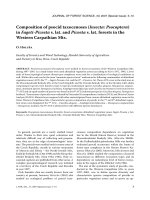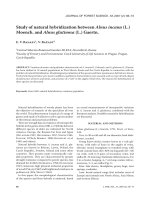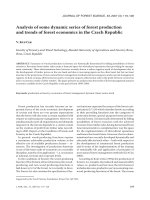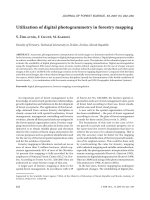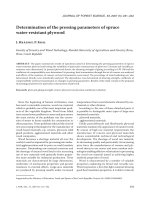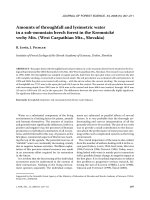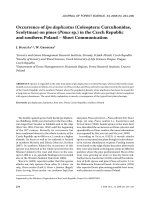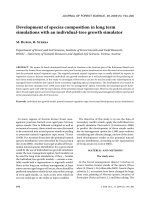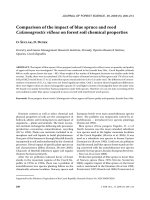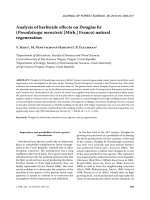Báo cáo lâm nghiệp: " Comparison of deposition fluxes on the open area and in mountain spruce stands of different density" pdf
Bạn đang xem bản rút gọn của tài liệu. Xem và tải ngay bản đầy đủ của tài liệu tại đây (216.38 KB, 8 trang )
J. FOR. SCI., 55, 2009 (9): 395–402 395
JOURNAL OF FOREST SCIENCE, 55, 2009 (9): 395–402
Forest ecosystems are open systems exchang-
ing energy and matters with its environment. e
maintenance of a relatively closed matter cycle is
necessary for the prosperous development of forest
ecosystems. Due to changes caused by anthropo-
genic activity, the composition of the atmosphere is
changing and will continue to change. e changes in
the atmosphere are reflected in the functioning and
growth of forests. e loss of vitality is related to nu-
tritional imbalances and brings about reduced stand
stability and productivity (R 1985; Z et
al. 1985; U 1986; Z, H 1986).
e atmospheric particles and gaseous compounds
are transferred to terrestrial and aquatic ecosystems
by dry and wet deposition. It is known that the com-
position of precipitation is altered considerably after
passing through the forest canopy. Internal nutrient
cycling includes the nutrients transfer from above-
ground biomass to forest soils in the form of litter
and also nutrient leaching from the various plant
parts or epiphytic organisms to the soil when rainfall
passes through the forest canopy as throughfall and
stemflow (P 1983; R 1996; W
et al. 1998; B et al. 2008; S
2008). Nutrient balances depend on the forest type
and forest structure (S et al. 1989; Y-
, I 1989; D et al. 1992;
B, Z 1997; F et al. 2002; R
et al. 2002), site characteristics (
F, K 1999;
K 2004; B et al. 2007; D V et
al. 2007; F et al. 2007) and weather conditions
(B, Z 1997; B, T
2001), and may reflect different patterns of behaviour
of forest ecosystems.
Air pollution which is the main cause of forest soil
acidification was recognized as a serious problem
and European countries have made a great effort to
evaluate the situation and to prevent further damage
Supported by the Ministry of Education, Youth and Sports of the Czech Republic, Research Project No. MSM 6215648902, and
the Ministry of Environment of the Czech Republic, Research Project No. VaV MŽP SP/2e3/172/07.
Comparison of deposition fluxes on the open area
and in mountain spruce stands of different density
I. M, I. D, S. T
Faculty of Forestry and Wood Technology, Mendel University of Agriculture and Forestry
in Brno, Brno, Czech Republic
ABSTRACT: To better understand the chemical transformation of rainfall after the passage through the canopies it is
necessary to study throughfall deposition fluxes within forest stands. e comparison of bulk deposition fluxes of Ca,
Mg, K, S-SO
4
, N-NO
3
and N-NH
4
in mountain spruce stands of different stand density and bulk deposition fluxes on
the open area was made at the study site Bílý Kříž (Moravian-Silesian Beskids Mts., Czech Republic) during the period
of 1999–2006. A linear relationship between the amount of rainfall on the open area and the amount of throughfall
in the spruce stand was found. roughfall deposition fluxes of selected elements in the dense as well as in the sparse
spruce stands were higher when compared with bulk deposition fluxes on the open area. ere were mostly statistical
significant differences between the bulk deposition fluxes on the open area and those in the studied spruce stands. e
throughfall deposition fluxes of Ca, Mg, K and S-SO
4
were influenced by the spruce stand density.
Keywords: throughfall; Norway spruce; Moravian-Silesian Beskids Mts.; Czech Republic
396 J. FOR. SCI., 55, 2009 (9): 395–402
(e.g. “Convention on Long-range Transboundary Air
Pollution”, “International Cooperative Programme
on Integrated Monitoring of Air Pollution Effects
on Ecosystems”). In the Czech Republic the forests
in the border mountains and the forests at the high-
lands might be still endangered by the consequence
of former soil acidification in spite of the fact that
the concentrations of acidifying substances in the air
have substantially decreased. In this paper deposi-
tion fluxes of selected elements in mountain spruce
stands of different stand density and deposition
fluxes on the open area are evaluated at the study
site Bílý Kříž (Moravian-Silesian Beskids Mts., Czech
Republic) for the period of 1999–2006.
METHOD
e study site is located at Bílý Kříž in the Mora-
vian-Silesian Beskids Mts. (Czech Republic). Geo-
graphic coordinates, climatic and soil parameters of
the site are given in Table 1. Bulk deposition fluxes
on the open area and throughfall deposition fluxes of
Ca, Mg, K, S-SO
4
, N-NO
3
and N-NH
4
in the moun-
tain spruce stands of different stand density were
evaluated during the period of 1999–2006.
Spruce stand was planted in 1981 using four-years-
old seedlings of Picea abies (L.) Karst., hence the
trees age was 30 years in 2007. e mean slope of the
plot with the spruce stand is 13.5°, its exposure is SSE
and mean altitude 908 m a.s.l. Dolomitic limestone
(31% CaO, 21% MgO) was used for the aerial liming
of the spruce stand in 1983, 1985 and 1987 (3 t/ha
was applied every year, respectively). e studied
spruce stand is divided into two plots with different
stand density (FD – dense stand, FS – sparse stand).
Leaf area index and stand density of the spruce stand
on the studied plots are shown in Table 2.
For throughfall sampling in the spruce stands and
atmospheric precipitation sampling on the open
area, permanently open polyethylene sampling
vessels of an area of 335.33 cm
2
were used (B,
B 1985; N, B 1995). e
vessels were inserted into the thick-walled plastic
pipes in order to shield the samples from solar ra-
diation and to hold the funnels approximately 1 m
above the ground. ere were 7 collectors randomly
Table 1. Description of the study site Bílý Kříž (Moravian-Silesian Beskids Mts., Czech Republic)
Geographic coordinates 49 30'N, 18°2'E
Geological subsoil flysch layer with dominant sandstone
Soil characteristics
typical humo-ferric podzol with mor-moder form of surface humus, medium depth up to
shallow, loamy-sand or sandy loam, relatively low nutrient content, depth of 60–80 cm
Climate characteristic
moderately cold, humid, with abundant precipitation; mean annual air temperature 5.5 ± 0.3°C,
mean relative air humidity 82 ± 2%, mean annual sum of precipitation 1,121 ± 240 mm
Table 2. Maximum leaf area index and stand density of spruce stands on the studied plots (FD – dense stand, FS – sparse
stand) during the studied period 1999–2006
Leaf area index (m
2
/m
2
) Stand density (trees/ha)
FD FS FD FS
1999 10.8 8.0 2,600 2,100
2000 11.0 8.2 2,600 2,100
2001 11.5 6.7 2,600 1,880*
2002 11.7 7.7 2,480** 1,820**
2003 12.3 9.1 2,440** 1,820
2004 12.4 9.6 2,050** 1,650*
2005 11.8 10.0 2,040** 1,650
2006 8.5 7.6 1,440** 1,430**
*After thinning, **tree reduction due to the winter disaster
J. FOR. SCI., 55, 2009 (9): 395–402 397
distributed on each plot. e number of collectors
was reduced to 5 during winter. Bulk atmospheric
precipitation was sampled with one collector in
the nearby open area. Samples were taken once a
month in the winter season and in 14-day intervals
in the other seasons. Samples were transferred to
the laboratory and prepared for the analyses usu-
ally the next day after the sampling. In winter it was
sometimes necessary to wait one day because the
samples were frozen. e methods used for deter-
mination of studied elements are listed in Table 3.
e average amount of throughfall precipitation for
each sampling event was calculated as the arithmetic
mean of the amounts captured in the throughfall
collectors located on a particular plot. e fluxes
of elements (mekv/m
2
) in bulk precipitation and in
throughfall for each sampling event were calculated
as the product of the amount of water (l m
2
) and the
relevant element concentration (mekv/l). e
t-test
(Microsoft Excel) was used to compare fluxes of el-
ements on the open plot and under crowns, and to
analyze differences between throughfall fluxes in the
sparse and dense stands. Annual deposition fluxes of
elements were calculated as the products of mean
annual concentration of individual elements and
precipitation totals for the relevant years.
RESULTS AND DISCUSSION
During the studied period of 1999–2006 mean
monthly sums of rainfall on the open area were 109 ±
55 mm and 120 ± 60 and 109 ± 58 mm of throughfall
in the dense and sparse spruce stand, respectively.
Differences in throughfall and rainfall sums were the
result of different leaf area index and stand density
of the studied stands. Water intercepted by the stand
canopy of the sparse stand was vaporized faster than
in the dense stand, the accumulation and consequen-
tial conflux of water below the canopy was lower
and the interception of horizontal precipitation was
Table 3. List of methods and instruments used for the analysis of rainfall and throughfall waters
Parameter
to determine
Method Instrumentation
K, Mg, Ca atomic absorption spectrophotometry
AA 30 F4 VARIAN atomic absorption
spectrophotometer
NH
4
spectrophotometry at the wave-length of 655 nm after
the reaction with hypochlorite and salicylate catalyzed
by sodium nitroprusside
UV/VIS spectrophotometer
NO
3
, SO
4
high-performance ion exchange liquid chromatography
with the gradient elution
DX-600 chromatograph with gradient pump
GP50
FS: y = 1.02x – 3.25; R ² = 0.97
FD: y = 1.08x + 0.27; R ² = 0.98
0
50
100
150
200
250
0 50 100 150 200 250
Rainfall (mm)
Thoroughfall (mm)
FS FD
Fig. 1. e relationship between the amount of rainfall on the open area and throughfall in the studied spruce stands (FD – dense
stand – solid line, FS – sparse stand – dotted line) during the period of 1999–2006
roughfall (mm)
398 J. FOR. SCI., 55, 2009 (9): 395–402
amounts and rainfall on the open area amounts were
not significant on the level of significance α = 0.05.
e individual studied years differed both in the
precipitation amounts and in the annual distribu-
tion of precipitation. A linear relationship between
the amount of rainfall on the open area and the
amount of throughfall in the spruce stand was found
(Fig. 1). In the dense spruce stand the amount of
throughfall was higher in comparison with the open
area whereas in the sparse spruce stand the amount
of throughfall was the same in comparison with the
open area.
Water collected under the forest canopy nor-
mally contains substantially larger amounts of ions
than rainfall collected in the open area (Y,
I 1989; B, Z 1997; W et
al. 1998; F, K 1999; G et al. 2000;
B, T 2001; M et al.
2002; B et al. 2004; C et al. 2004;
D, K 2008). Bulk deposition fluxes
of selected elements in both the dense and the sparse
spruce stand were higher when compared with bulk
deposition fluxes on the open area (Tables 4 and 5).
Throughfall deposition fluxes were lower in the
sparse spruce stand when compared with the dense
spruce stand.
A comparison of bulk deposition fluxes of selected
elements on the open area and throughfall deposi-
tion fluxes in the dense and sparse spruce stands
was done for the period of 1999–2006. Statistically
significant differences (α = 0.05; t-test) were found
for calcium, magnesium, potassium and sulphate
ions (Table 6). Deposition fluxes of selected ele-
ments were dependent on the stand density (Ta-
ble 7). Statistically significant differences (α = 0.05;
t-test) were found in the throughfall deposition
fluxes of Ca, Mg, K and S-SO
4
between the dense and
sparse spruce stand. roughfall deposition fluxes
are influenced by the processes in the canopy layer.
In the denser stand we can expect a higher contri-
bution of dry deposition and a higher contribution
of elements that are leached out from the crowns.
Some elements are taken up by the canopy, which
lowers their throughfall deposition (B, Z
1997; D V et al. 2007; B et al. 2007;
F et al. 2007; B et al. 2008; D
et al. 2008).
CONCLUSION
roughfall deposition fluxes of Ca, Mg, K, S-SO
4
,
N-NO
3
and N-NH
4
in the mountain spruce stands of
different stand density and bulk deposition fluxes on
the open area were measured at the study site Bílý
Table 4. Mean annual deposition fluxes of selected
elements in the bulk precipitation on the open area in
some localities in Europe (values in kg/ha)
Element
Deposition
fluxes
Locality
Ca
2+
6.7 ± 1.6 Bílý Kříž (Czech Republic)
1
2.1 Austria
2
12.4 Czech Republic
3
Mg
2+
1.2 ± 0.5 Bílý Kříž (Czech Republic)
1
0.3 Austria
2
2.4 Czech Republic
3
K
+
4.1 ± 1.2 Bílý Kříž (Czech Republic)
1
3.2 Austria
2
3.3 Czech Republic
3
S-SO
4
2 –
10.0 ± 1.5 Bílý Kříž (Czech Republic)
1
4.2–5.7 Czech Republic
4
5.7–8.0 Czech Republic
5
3.3–4.2 Czech Republic
6
N-NO
3
–
5.4 ± 0.7 Bílý Kříž (Czech Republic)
1
3.2–6.3 Czech Republic
4
4.5–6.3 Czech Republic
5
1.8–3.2 Czech Republic
6
N-NH
4
+
6.9 ± 1.0 Bílý Kříž (Czech Republic)
1
5.1–7.5 Czech Republic
4
5.1–7.5 Czech Republic
5
3.3–5.1 Czech Republic
6
1
Bílý Kříž locality (Moravian-Silesian Beskids Mts.), 908 m
a.s.l., 1999–2006
2
Kreinbach locality (Lower Austria), 480 m a.s.l., 2002–2003
(B et al. 2008)
3
Jablunkov locality (Moravian-Silesian Beskids Mts.), 550 to
700 m a.s.l., 2004–2006 (N et al. 2008)
4
Area of the Krušné hory Mts., 700–1,200 m a.s.l., 2003–2005
(L et al. 2008)
5
Area of the Moravian-Silesian Beskids Mts., 700–1,300 m
a.s.l., 2003–2005 (L et al. 2008)
6
Area of Southern Bohemia, 2003–2005 (L et al.
2008)
lower as well. Mainly the interception of horizontal
precipitation is important in mountain forest stands.
us the lower amount of water penetrated onto the
forest floor in the sparse stand. From the statistical
point of view the differences between the throughfall
J. FOR. SCI., 55, 2009 (9): 395–402 399
Table 5. Mean annual throughfall deposition fluxes of selected elements in the spruce stands in some localities in Europe
(values in kg/ha)
Element Deposition fluxes Locality
Ca
2+
15.7 ± 3.4 Bílý Kříž (Czech Republic) – FD stand
1
11.6 ± 5.1 Bílý Kříž (Czech Republic) – FS stand
1
7.0 Italy
2
9.5 Estonia
3
9.5 Austria
4
18.3 Czech Republic
5
Mg
2+
4.2 ± 1.1 Bílý Kříž (Czech Republic) – FD stand
1
3.0 ± 1.6 Bílý Kříž (Czech Republic) – FS stand
1
2.0 Italy
2
2.0 Estonia
3
2.2 Austria
4
2.6–4.0 Austria
6
K
+
19.2 ± 6.0 Bílý Kříž (Czech Republic) – FD stand
1
12.7 ± 3.4 Bílý Kříž (Czech Republic) – FS stand
1
19.0 Italy
2
2.9 Estonia
3
13.0 Austria
4
6.6–9.6 Austria
6
20.7 Czech Republic
5
S-SO
4
2 –
22.5 ± 4.1 Bílý Kříž (Czech Republic) – FD stand
1
16.4 ± 3.4 Bílý Kříž (Czech Republic) – FS stand
1
3.0–5.0 Italy
2
4.1 Estonia
3
3.1–7.9 Austria
6
N-NO
3
–
8.9 ± 0.9 Bílý Kříž (Czech Republic) – FD stand
1
7.4 ± 1.5 Bílý Kříž (Czech Republic) – FS stand
1
3.0 Italy
2
2.1 Estonia
3
2.3–4.3 Austria
6
N-NH
4
+
7.7 ± 1.4 Bílý Kříž (Czech Republic) – FD stand
1
6.6 ± 1.4 Bílý Kříž (Czech Republic) – FS stand
1
3.5 Italy
2
2.5 Estonia
3
1.6–4.2 Austria
6
1
Bílý Kříž locality (Moravian-Silesian Beskids Mts.), 908 m a.s.l., 1999–2006 (FD stand – dense stand, FS – sparse stand)
2
Localities Renon and Lavazé Pass (Southern Alps), 1,750 and 1,780 m a.s.l., 1993–1996 (M et al. 2002)
3
Saarejärve locality, 1995–2002 (P et al. 2006)
4
Kreinbach locality (Lower Austria), 480 m a.s.l., 2002–2003 (B et al. 2008)
5
Jablunkov locality (Moravian-Silesian Beskids Mts.), 550–700 m a.s.l., 2004–2006 (N et al. 2008)
6
Eiseneck locality (Northern Alps), 1,300 m a.s.l., 1996–1998 (K 2003)
400 J. FOR. SCI., 55, 2009 (9): 395–402
Kříž in the Moravian-Silesian Beskids Mts. (Czech
Republic) during the period of 1999–2006.
A linear relationship between the amount of rain-
fall on the open area and the amount of throughfall
in the studied dense and sparse spruce stands was
found. Water collected under the forest canopy con-
tained larger amounts of ions than rainfall collected
in the open area. Statistically significant differences
(α = 0.05) were found between the throughfall depo-
sition fluxes of Ca, Mg, K and S-SO
4
in the spruce
stands and bulk deposition fluxes on the open area.
Throughfall deposition fluxes of Ca, Mg, K and
Table 7. Statistical analysis (t-test) between the deposition fluxes of selected elements (mekv/m
2
) in the dense and in the
sparse spruce stand during the period of 1999–2006 (X – statistically significant differences at the level of α = 0.05)
Ca
2+
Mg
2+
K
+
N-NH
4
+
S-SO
4
2 –
N-NO
3
–
1999 X X X – X X
2000 X X X – X –
2001 X X X – X –
2002 X X X – X X
2003 X – X – X –
2004 – – – – – –
2005 – – – – – –
2006 – – – – – –
1999–2006 X X X – X X
Table 6. Statistical analysis (t-test) between the deposition fluxes of selected elements (mekv/m
2
) on the open area
and in the dense (FD) and in the sparse (FS) spruce stand during the period of 1999–2006 (X – statistically significant
differences at the level of α = 0.05)
Ca
2+
Mg
2+
K
+
N-NH
4
+
S-SO
4
2 –
N-NO
3
–
1999
FD X X X – X X
FS – – – – – X
2000
FD X X X – X –
FS X X X – X –
2001
FD X X X – X X
FS X X X – X –
2002
FD X X X – X X
FS X X X – X –
2003
FD X X X – X X
FS X X X – X –
2004
FD X X X – X –
FS – – X – – –
2005
FD X X X X X X
FS X X X – X –
2006
FD X X X X X X
FS X X X – X X
1999–2006
FD X X X – X X
FS X X X – X X
J. FOR. SCI., 55, 2009 (9): 395–402 401
S-SO
4
were dependent on the stand density. Mean
annual bulk deposition fluxes of Ca, Mg, K, S-SO
4
,
N-NO
3
and N-NH
4
on the open area calculated for
the period of 1999–2006 were 6.7, 1.2, 4.1, 10.0, 5.4
and 6.9 kg/ha, respectively. Mean annual throughfall
deposition fluxes of Ca, Mg, K, S-SO
4
, N-NO
3
and
N-NH
4
in the dense and sparse spruce stand were
15.7 and 11.6, 4.2 and 3.0, 19.2 and 12.7, 22.5 and
16.4, 8.9 and 7.4, 7.7 and 6.6 kg/ha, respectively.
R e f e r e n c e s
BALESTRINI R., TAGLIAFERRI
A., 2001. Atmospheric
deposition and canopy exchange processes in alpine forest
ecosystems (northern Italy). Atmospheric Environment,
35:
6421–6433.
BALESTRINI R., ARISCI S., BRIZZIO M.C., MOSELLO R.,
ROGORA M., TAGLIAFERRI A
., 2007. Dry deposition
of particles and canopy exchange: Comparison of wet,
bulk and throughfall deposition at five forest sites in Italy.
Atmospheric Environment, 41: 745–756.
BARBIER S., GOSSELIN F., BALANDIER P., 2008. Influence
of tree species on understory vegetation diversity and mech-
anisms involved. A critical review for temperate and boreal
forests. Forest Ecology and Management, 254: 1–15.
BÉLANGER N., PARÉ D., COURCHENSE F
., 2004. Regression
equations for estimating throughfall nutrient fluxes using
wet deposition data and their applicability for simulating
the soil acid-base status using the dynamic forest soil-atmos-
phere model SAFE. Ecological Modelling, 175: 151–167.
BERGER T.W., UNTERSTEINER H., SCHUME H., JOST G.,
2008. roughfall fluxes in a secondary spruce (Picea abies),
a beech (Fagus sylvatica) and a mixed spruce-beech stand.
Forest Ecology and Management, 255: 605–618.
BIBNLER R., ZECH W
., 1997. Atmospheric deposition and
impact of forest thinning on the throughfall of mountain
forest ecosystems in the Bavarian Alps. Forest Ecology and
Management, 95: 243–251.
BLOCK J., BARTELS
U., 1985. Ergebnisse der Schadsstiff-
depositionsmessungen in Waldökosystem in den Mess-
jahren 1981/82 und 1982/83. Forschung und Beratung,
39: 12–14.
CHIWA M., CROSSLEY A., SHEPPARD L.J., SAKUGAWA
H., CAPE
J.N., 2004. roughfall chemistry and canopy
interactions in a Sitka spruce plantation sprayed with six
different simulated polluted mist treatment. Environmental
Pollution, 127: 57–64.
De VRIES W., Van der SALM C., REINDS G.J., ERISMAN
J.W., 2007. Element fluxes through European forest ecosys-
tems and their relationships with stand and site character-
istics. Environmental Pollution, 148: 501–513.
DRAAIJERS
G.P.J., Van EK R., MEIJERS R., 1992. Research
on the impact of forest stand structure on atmospheric
deposition. Environmental Pollution, 75: 243–249.
DRÁPELOVÁ I., KULHAVÝ
J., 2008. Deposition flows and
chemical composition of seepage waters in stands with
spruce monoculture managed in different ways – results
in 2007. Beskydy: 117–124.
DRÁPELOVÁ I., TRUPAROVÁ S., MARKOVÁ I., KULHAVÝ
J., 2008. Deposition flows and the chemical composition of
soil solution in young Norway spruce stands – a long-term
ecological study (2001–2006). In: Lysimeters for Global
Change Research: Biological Processes and the Environ-
mental Fate of Pollutants. München, Helmholtz Zentrum
München – German Research Centre for Environmental
Health: 58.
FENN M.E., KIEFER
J.W., 1999. roughfall deposition of
nitrogen and sulfur in a Jeffrey pine forest in the San Gabriel
Mountains, southern California. Environmental Pollution,
104: 179–187.
FISCHER R., MUES V., ULRICH E., BECHER G., LORENZ
M., 2007. Monitoring of atmospheric deposition in Euro-
pean forests and an overview on its implication on forest
condition. Applied Geochemistry, 22: 1129–1139.
FRANKLIN J.F., SPIES T.A., Van PELT R., CAREY A.B.,
THORNBURGH D.A., BERG D.R., LINDENMAYER D.B.,
HARMON M.E., KEETON W.S., SHAW D.C., BIBLE K.,
CHEN
J., 2002. Disturbances and structural development
of natural forest ecosystems with silvicultural implications,
using Douglas-fir forests as an example. Forest Ecology and
Management, 155: 399–423.
GORDON A.M., CHOURMOUZIS CH., GORDON
A.G., 2000.
Nutrient inputs in litterfall and rainwater fluxes in 27-year old
red, black and white spruce plantations in Central Ontario,
Canada. Forest Ecology and Management, 138: 65–78.
KATZENSTEINER K., 2003. Effect of harvesting on nutrient
leaching in a Norway spruce (Picea abies Karst.) ecosystem
on a Lithic Leptosol in the Northern Limestone Alps. Plant
and Soil, 250: 59–73.
KNULST J
.C., 2004. Ratio between throughfall and open-field
bulk precipitation used for quality control in deposition
monitoring. Atmospheric Environment, 38: 4869–4878.
LORENZ M., FISCHER R., BECHER G., GRANKE O., SEID-
LING W., FERRETTI M., SCHAUB M., CALATAYUD
V., BACARO G., GEROSA G., ROCCHINI D., SANZ M.,
2008. Forest Condition in Europe. 2008 Technical Report.
Hamburg, BFH.
MARCHETTI F., TAIT D., AMBROSI P., MINERBI S., 2002.
Atmospheric deposition at four forestry sites in an Alpine
region on Trentino – South Tyrol. Journal of Limnology,
61: 148–157.
MOFFAT A.J., KVAALEN H., SOLBERG S., CLARKE N.,
2002. Temporal trends in throughfall and soil water chem-
istry at three Norwegian forests, 1986–1997. Forest Ecology
and Management, 168: 15–28.
NIEHUS B., BRUGGEMANN L
., 1995. Untersuchungen zur
Deposition Luftgetragener Stoffe in der Dubener Heide.
Beitr. Forstwirtsch. u. Landsch.ökol., 29: 4.
402 J. FOR. SCI., 55, 2009 (9): 395–402
NOVOTNÝ R., LACHMANOVÁ Z., ŠRÁMEK V., VOR
-
TELOVÁ L., 2008. Air pollution load and stand nutrition
in the Forest District Jablunkov, part Frýdek. Journal of
Forest Science, 54: 49–54.
PAJUSTE K., FREY J., ASI E., 2006. Interaction of atmospheric
deposition with coniferous canopies in Estonia. Environ-
mental Monitoring and Assessment, 112: 177–196.
PARKER G.G., 1983. roughfall and stemflow in the forest nu-
trient cycle. Advances in Ecological Research, 13: 57–133.
REHFUESS K.E., 1985. Vielfältige formen der fichtener-
krankung in Südwest Deutschland (1985). In: NIESSLEIN
E., VOSS G. (eds), Was wir über das Waldsterbenwissen:
124–130.
REYNOLDS B., 1996. Technical note. Estimating the total
deposition of base cations from throughfall measurements.
Science of the Total Environment, 180: 183–186.
ROTHE A., HUBER C., KREUTZER K., WEIS W.,
2002.
Deposition and soil leaching in stands of Norway spruce
and European beech: results from the Höglwald research
in comparison with other European case studies. Plant and
Soil, 240: 33–45.
SHACHNOVICH Y., BERLINER P.R., BAR P., 2008. Rainfall
interception and spatial distribution of throughfall in a
pine forest planted in an arid zone. Journal of Hydrology,
349: 168–177.
STOGSDILL W.R., WITTWER R.F., HENNESSEY T.C.,
DOUGHERTY P.M., 1989. Relationship between through-
fall and stand density in a Pinus taeda plantation. Forest
Ecology nad Management, 29: 105–113.
ULRICH B., 1986. Die Rolle der bodenversauerung beim
waldsterben: langfristige Konsequenzen und forstliche
Möglichkeiten. Forstwissenschaftliches Centralblatt, 105:
421–435.
WHELAN M.J., SANGER L.J., BAKER M., ANDERSON
J.M., 1998. Spatial patterns of throughfall and mineral
ion deposition in a lowland Norway spruce (Picea abies)
plantation at the plot scale. Atmospheric Environment,
32: 3493–3501.
YOSHIDA S., ICHIKUNI M.
, 1989. Role of forest canopies in
the collection and neutralization of airborne acid substance.
Science Total Environment, 84: 35–43.
ZECH W., SUTTNER T., POPP E., 1985. Elemental analysis
and physiological response of forest trees in SO
2
-polluted
areas of NE-Bavaria. Water, Air, and Soil Pollution, 25:
175–183.
ZÖTTL H.W., HÜTTL R.F., 1986. Nutrient supply and forest
decline in Southwest Germany. Water, Air, and Soil Pollu-
tion, 48: 87–109.
Received for publication March 30, 2009
Accepted after corrections April 30, 2009
Corresponding author:
RNDr. I M, CS., Mendelova zemědělská a lesnická univerzita v Brně, Lesnická a dřevařská fakulta,
Zemědělská 1, 613 00 Brno, Česká republika
tel.: + 420 545 134 189, fax: + 420 455 211 422, e-mail:
Srovnání depozičních toků na volné ploše a v horských smrkových porostech
s různou hustotou
ABSTRAKT: Studium depozičních toků v lesních porostech je důležité pro pochopení chemických změn, ke kterým
dochází při průchodu srážek korunovou vrstvou porostů. V letech 1999–2006 byly sledovány depoziční toky Ca, Mg,
K, S-SO
4
, N-NO
3
a N-NH
4
v horském smrkovém porostu na dvou plochách s různou hustotou a na volné ploše na
experimentálním ekologickém pracovišti Bílý Kříž (Moravskoslezské Beskydy). Byla zjištěna lineární závislost mezi
množstvím srážek dopadajících na volnou plochu a množstvím podkorunových srážek na obou studovaných plochách.
Podkorunové depoziční toky vybraných prvků byly ve sledovaném období vyšší ve smrkových porostech než depo-
ziční toky na volné ploše. Pro většinu vybraných prvků byly zjištěny statisticky významné rozdíly mezi depozičními
toky na volné ploše a ve studovaných smrkových porostech. Depoziční toky Ca, Mg, K a S-SO
4
byly ve smrkovém
porostu ovlivněny jeho hustotou.
Klíčová slova: podkorunové srážky; smrk ztepilý; Moravskoslezské Beskydy; Česká republika
